A Thai Red Curry Paste recipe that’s doable by any home cook and yields a curry that truly is as great as what you get at the very best Thai restaurants. The DNA of this paste is a recipe by the great David Thompson, a highly regarded Thai food expert.
Like Green Curry Paste, a homemade curry paste yields the freshest, most fragrant curry that you can never buy in a jar. Use this red curry paste recipe for Thai Red Curry, fish cakes or add zing to Thai Fried Rice!
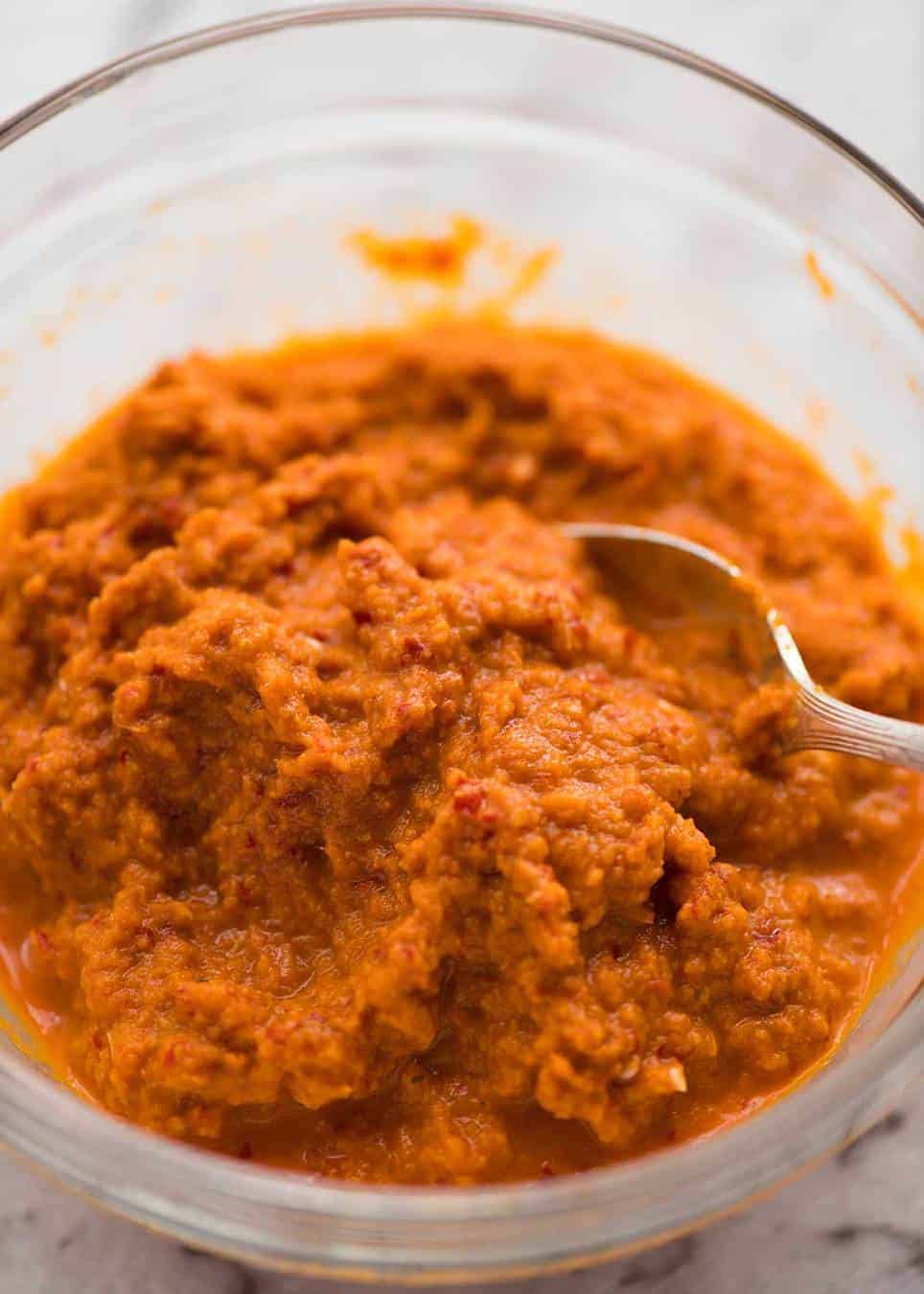
Thai red curry paste
This Thai Red Curry Paste recipe is a RecipeTin Family effort, refined over years with multiple family meals during which we critiqued the latest version.
We’re a tough crowd, when it comes to each other. We don’t hold back punches. You should have heard the critiques for the earlier versions. “It lacks complexity!” -> “Something’s missing… I don’t know what. Something’s missing!“-> “It’s nice, but it’s brown not red.” -> “Why is it gritty?” “The veggies are too soft, the chicken’s not tender enough” -> “It’s almost there! Almost!” ?
Actually, the cook is usually the toughest critic. We’re pretty hard on ourselves!
But finally, the whole RecipeTin Family approves and we declare this curry paste to be The One. A Thai Red Curry Paste that’s totally doable by any home cook that makes a Thai Red Curry that rivals those served by the best Thai restaurants in Sydney – and we are known for great Thai food here!
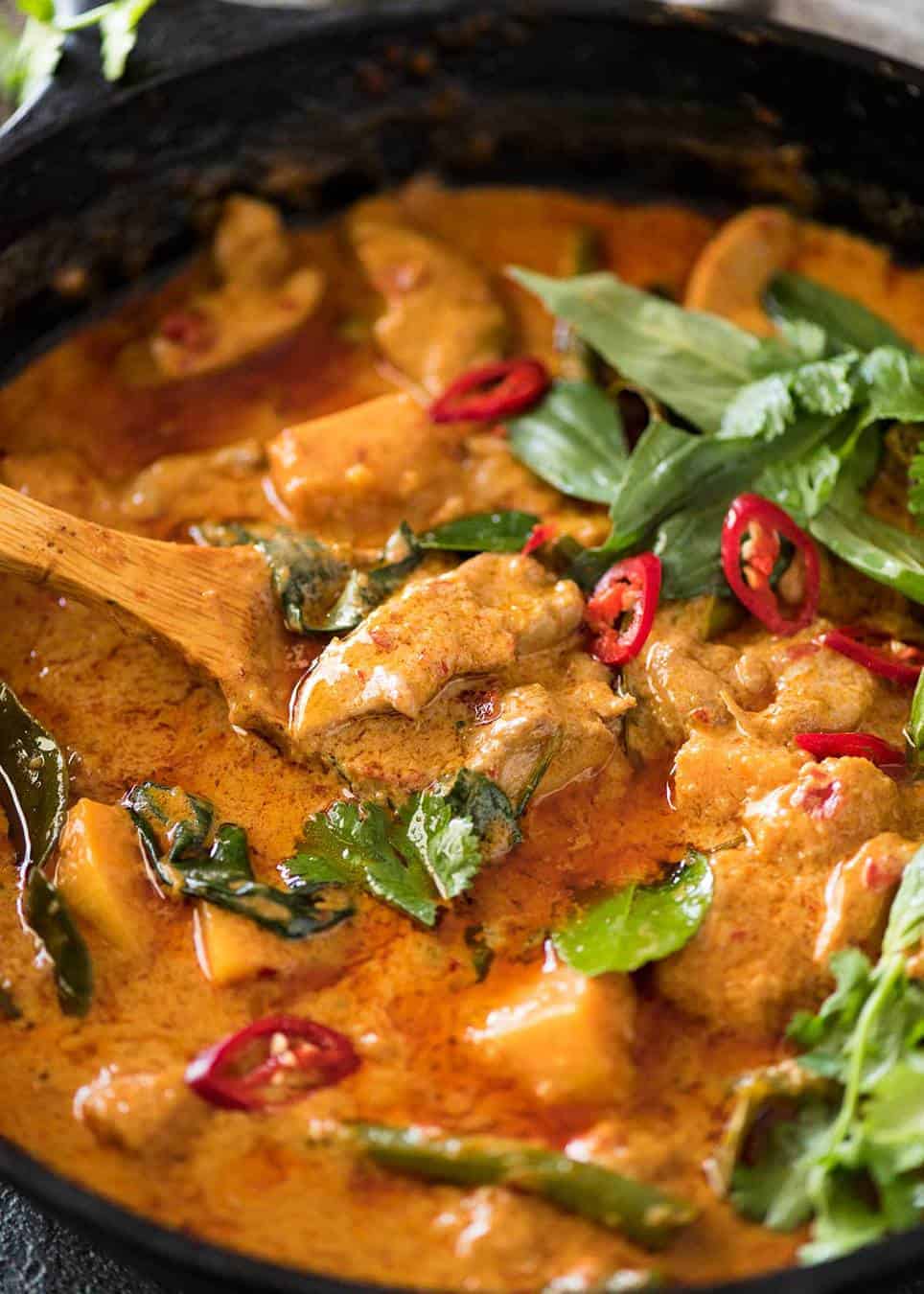
How Authentic Thai Red Curry Paste is made
Truly authentic Thai curry pastes require serious effort – the paste is made by grinding the ingredients in a mortar and pestle and it takes over 30 minutes. The first time I tried it, I was cursing like a sailor less than 10 minutes in, chilli bits flying everywhere.
The 2nd time I tried it, I gave up 3 minutes in and scraped everything into a blender.
Blender is the way to go. Blender all the way!!!
Much of the base for this Thai Red Curry Paste is drawn from Chef and restaurant recipes. Little tweaks here and there to balance it to my taste to make it as close as I could to the red curries served at my favorite Thai restaurants.
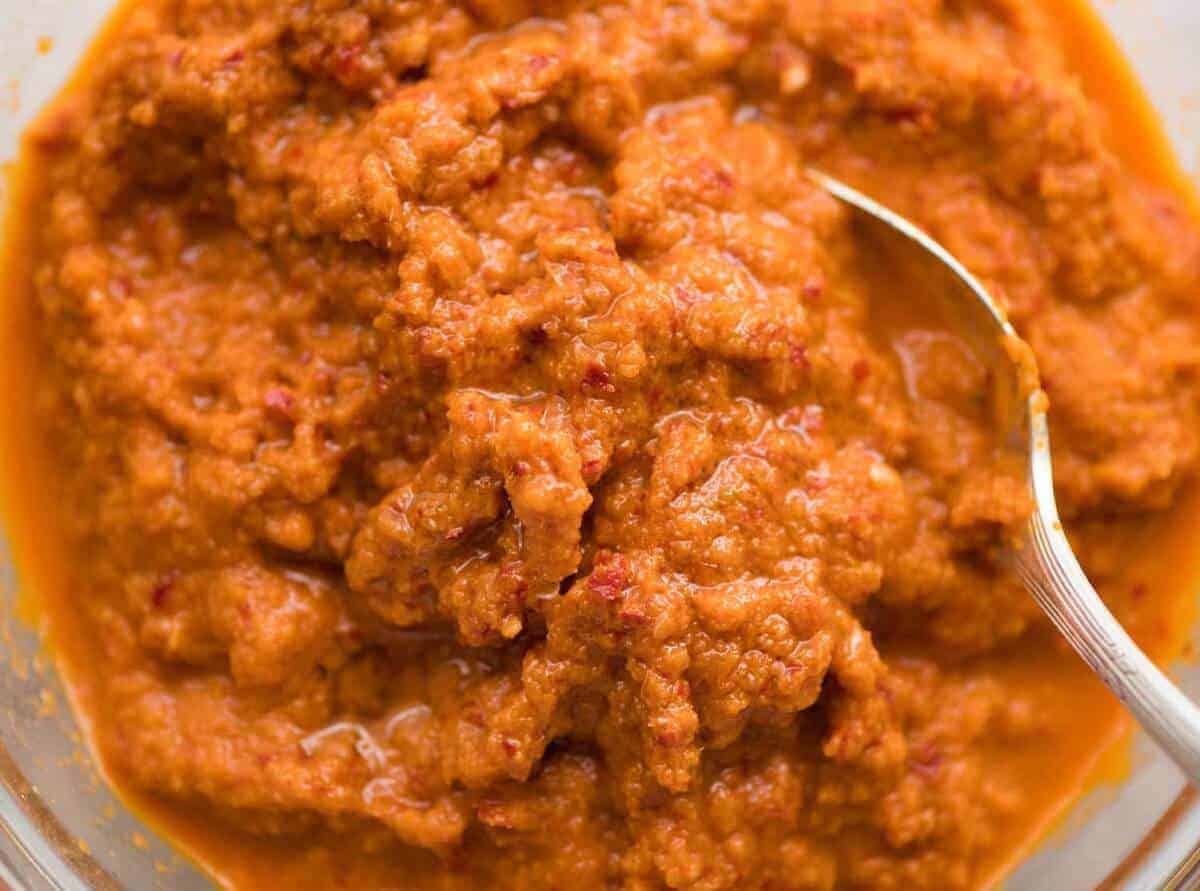
What goes in Thai Red Curry Paste
There’s no denying that you’ll probably require a trip to the Asian grocery store to get all the ingredients for Thai Red Curry Paste, unless your local supermarket has an exceptionally well stocked Asian section! But everything should be relatively simple to hunt down, they are all pretty common Asian ingredients. Just show the shop keeper these photos if you can’t find them!
The star ingredient in Thai Red Curry is dried red chillies. Chop before hydrating in boiled water to shake the seeds loose (seeds = spiciness) and also, they hydrate better = easier to whizz into a smooth paste.
Using fresh red chillies won’t produce the same end result, I tried. Dried chillies have an earthy flavour, they are not crazy spicy and it’s a key flavour base for red curry.
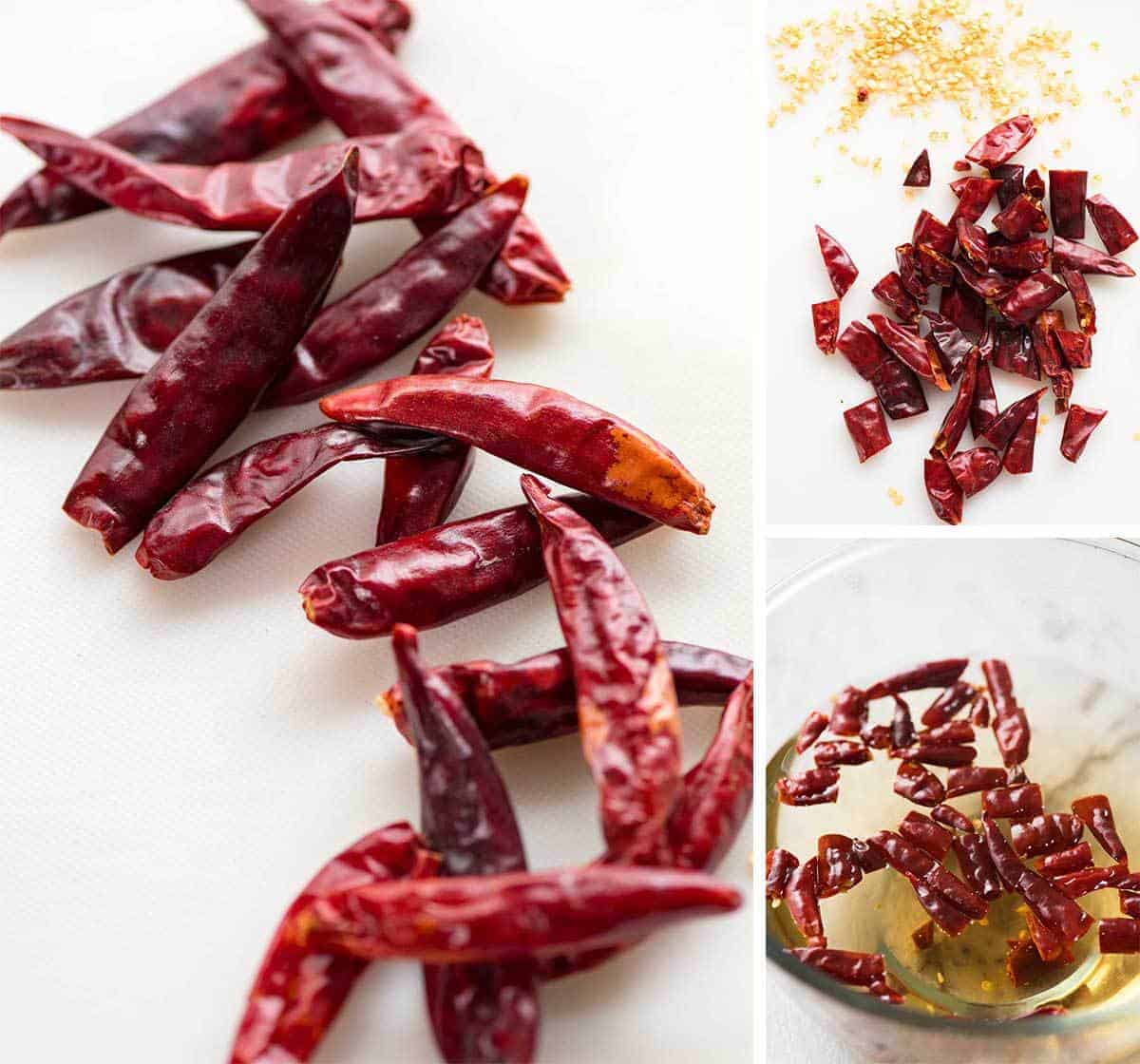
Another ingredient in Thai Red Curry Paste that is a bit unique is galangal. It looks like ginger, but tastes more citrusy and is harder to cut. If you can’t find it, substitute with ginger and lime zest.
Because galangal is so tough, it can be one of the offenders of grainy curry sauce because consumer grade blenders and food processors can’t blitz it finely enough if you just throw chunks in. In our Red Curry Paste readings, we never came across a recipe that called for galangal to be grated. But this step is truly worth taking if you want to ensure your curry is smooth, especially if you have an ordinary blender. I have a powerful Vitamix blender, and I still grate my galangal.
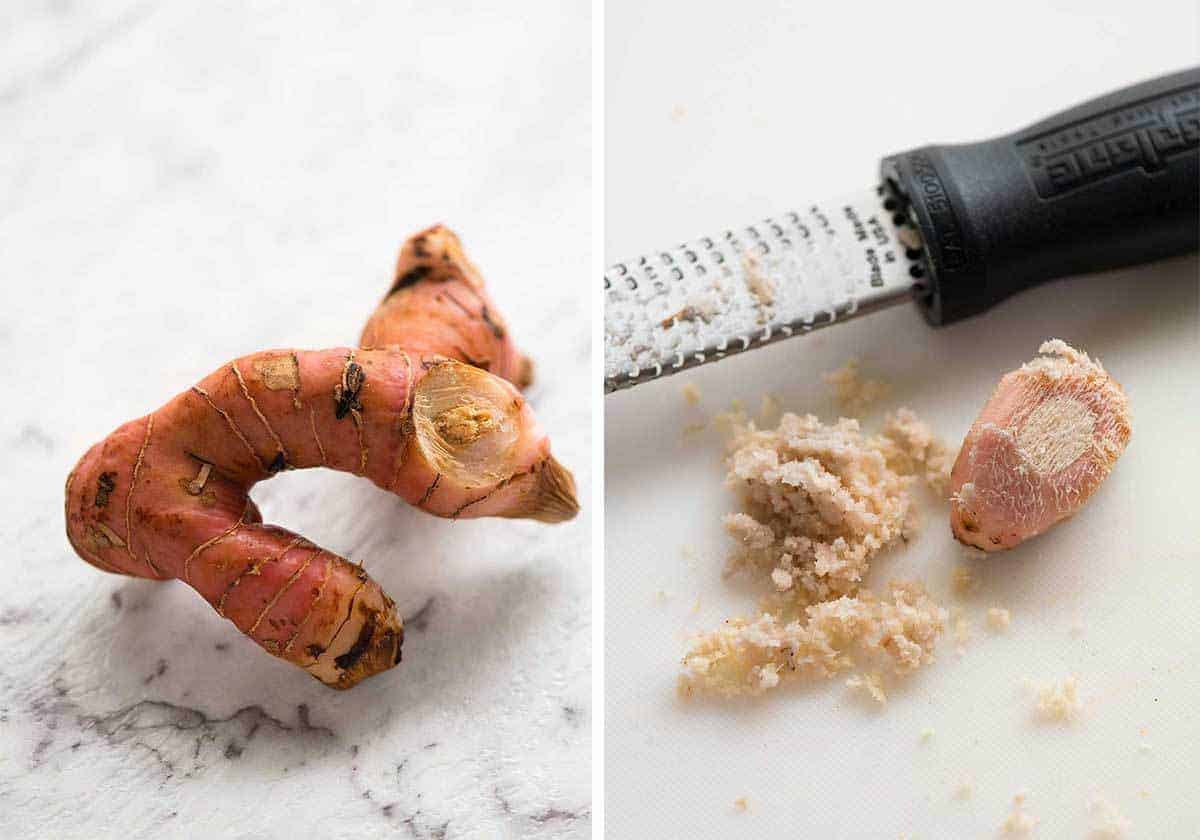
The other key ingredient in Thai Red Curry Paste is Shrimp Paste. This is where our recipe differs from some authentic Thai recipes. Made from fermented, dried shrimp (prawns), most Thai recipes use pure shrimp paste which is called Belacan. Typically, it’s sold in dried blocks which is required to be soaked to rehydrate before use.
However, we like to use Shrimp Paste that comes in a jar with oil and some other flavourings added. This is a tip I picked up from Sujet Saenkham, the chef of the very popular Spice I Am Thai restaurants in Sydney, and it was our final tweak that took our curry from “it’s almost there!” to “YES!!!! This is truly restaurant quality!!!!”. ( <- OK, there may have been a little jiggy upon the first taste test).
The main reason I use this is for the oil because this is the key thing we noticed between hand grinding and using a blender – the extraction of natural oils from the chilli. You can’t achieve this using a blender, only grinding by hand.
Solution: Use Shrimp Paste in oil. There are many brands out there. I use Por Kwan which is the most popular brand at Asian supermarkets here in Australia. Just check the jar and as long as it has more than just shrimp and salt in the ingredients, it should be just fine.
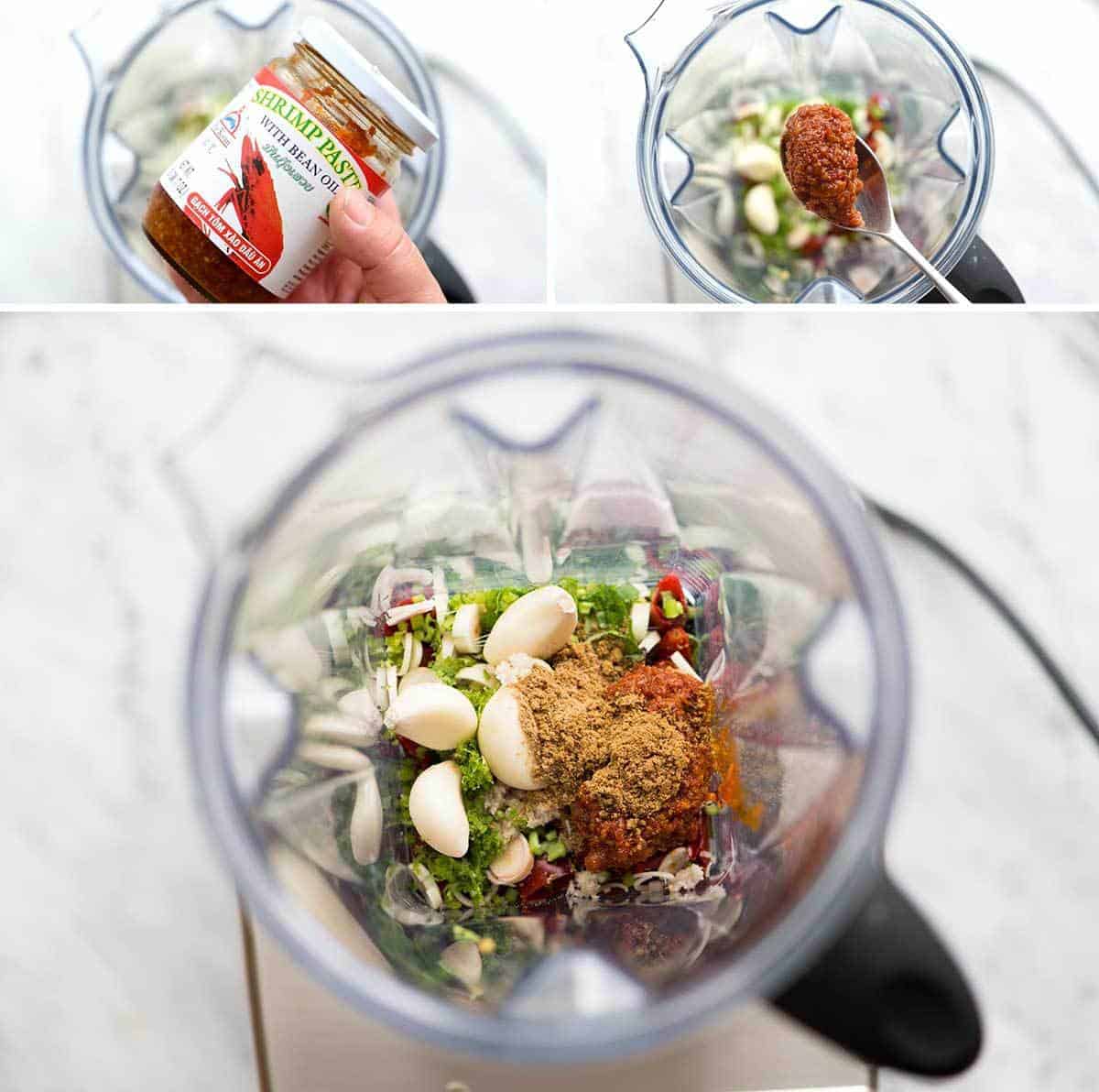
The other ingredients in Thai Red Curry Paste are more familiar every day ingredients: lemongrass, coriander / cilantro, eschalots / shallots (baby red onions) and lime.
Plonk it all into the blender, and blitz away until smooth – this can take a good 30 seconds or even up to 1 minute, depending on how powerful your blender is.
And this is what it looks like when it comes out – kind of more orangey than a deep red (PS Curry paste in jars usually has colouring). You’ll be strangely disappointed when you do a taste test – it doesn’t taste like anything amazing. Have faith, my friends, have faith!
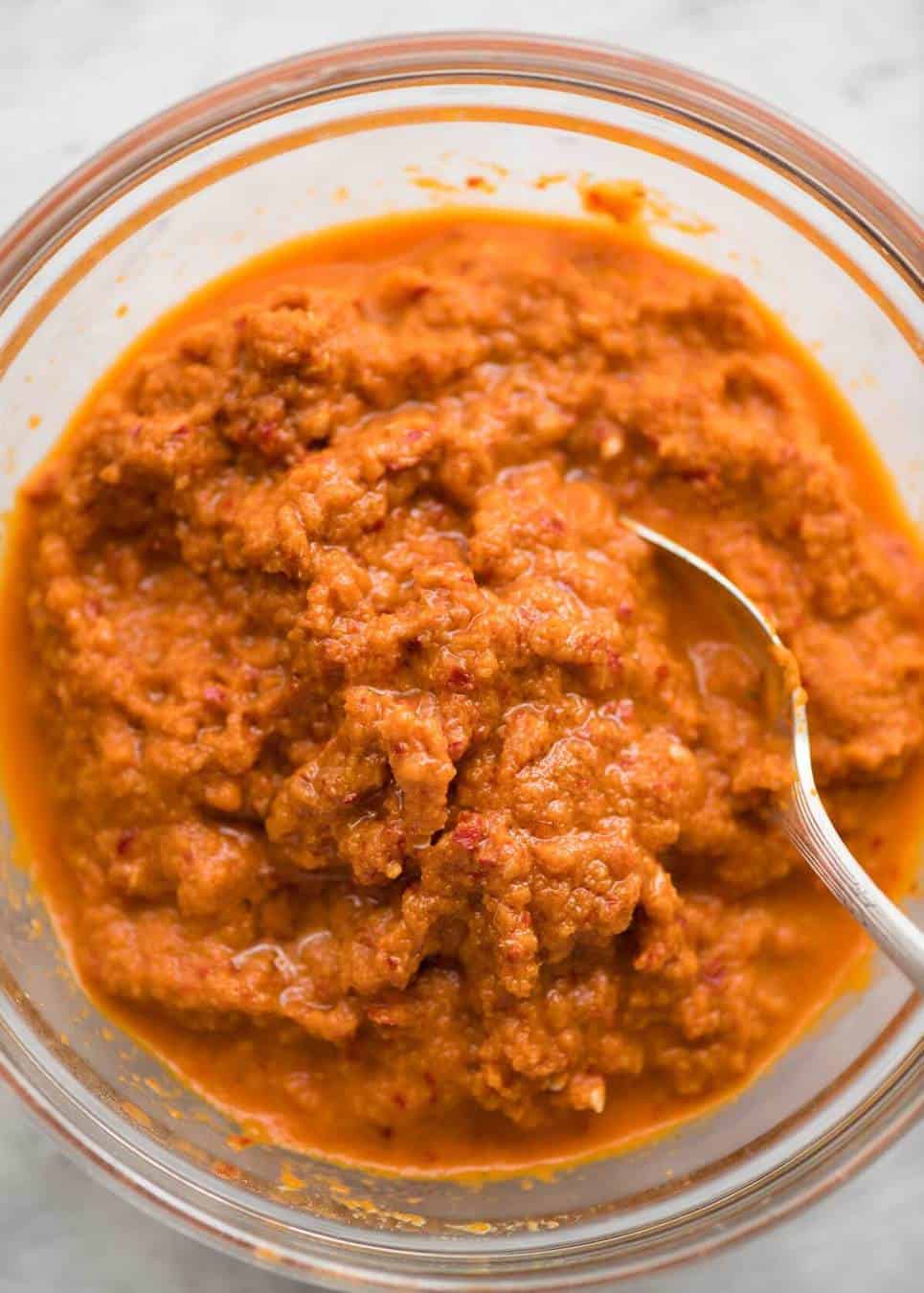
Thai Red Curry Paste is a base for many Thai dishes, from Thai Fish Cakes to stir fries, fried rice to noodles. But the most well known use is probably Thai Red Curry.
If you’ve ever made red curry using store bought taste, you will be blown away how much better made from scratch is. If you’re Thai Food connoisseur, you’ll be astonished how close this is to the red curries served at great Thai restaurants. The likes of Longrain, Spice I Am, Chat Thai, Sailors Thai and Khao Pla – the red curries at these restaurants were our benchmark.
We hope you enjoy this as much as we do! – Nagi x
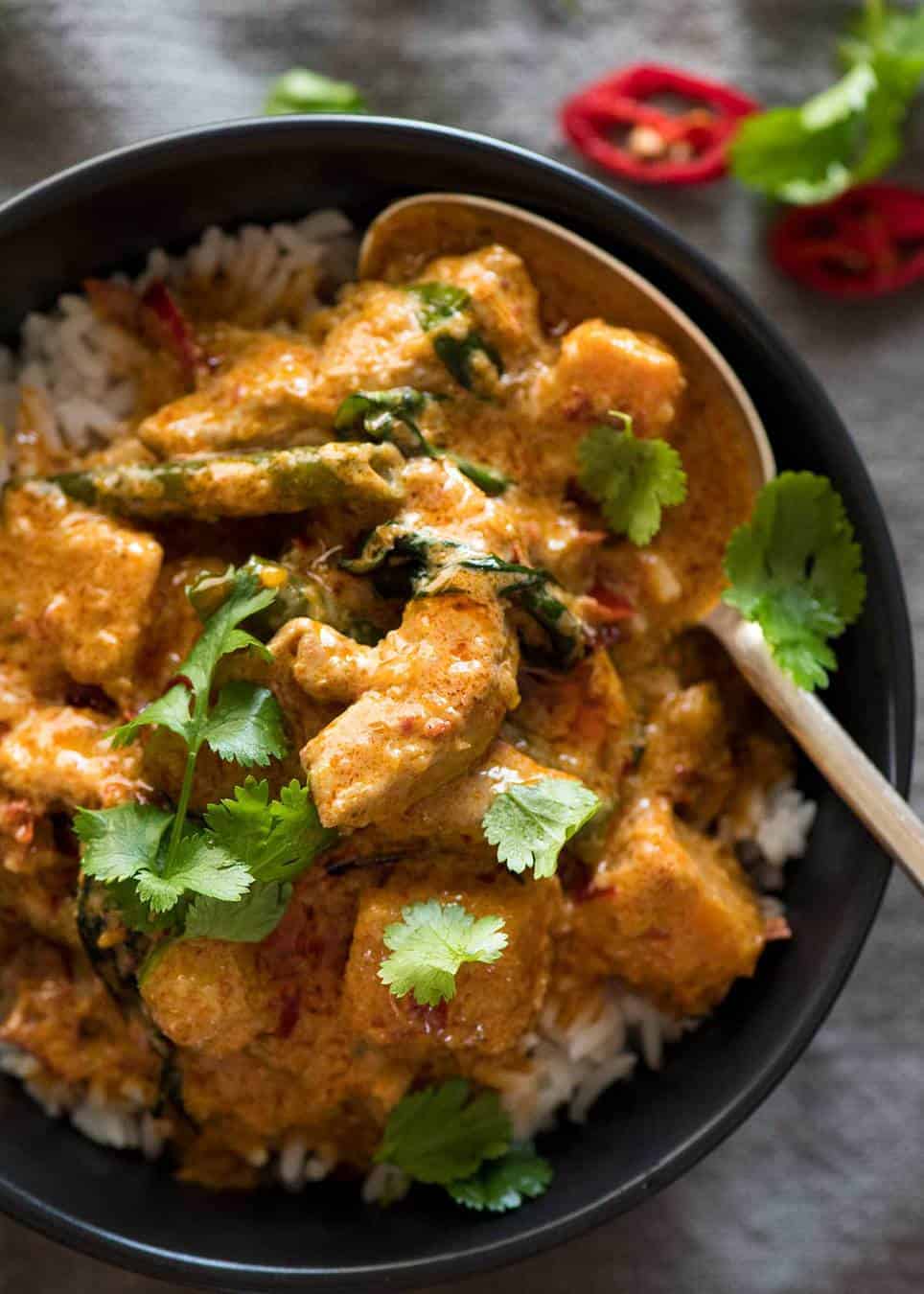
WATCH HOW TO MAKE IT
Hungry for more? Subscribe to my newsletter and follow along on Facebook, Pinterest and Instagram for all of the latest updates.
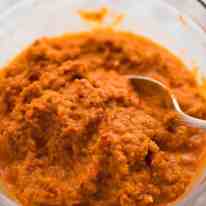
Thai Red Curry Paste
Ingredients
- 16 dried chillis , chopped into 1 cm / 0.5" pieces seeds shaken out (Note 1)
- 2 tbsp lemongrass , sliced, reedy outer skin removed (1 large) (Note 2)
- 1 tbsp grated galangal, peeled and grated (Note 3)
- 4 garlic cloves, peeled whole
- 1 tbsp shrimp paste in oil (Note 4)
- 1/2 tsp ground coriander
- 1/2 tsp ground cumin
- 1 tbsp chopped coriander/cilantro stem and roots (Note 5)
- 2 red shallots , peeled and roughly chopped (Note 6)
- 1 tsp lime zest
- ¼ cup reserved chilli soaking water
Instructions
- Taste dried chillies for spiciness - see Note 1. Place the chopped chillies in a large boil and pour over about 3 cups of freshly boiled water. Leave to soak for a good 30 minutes or so.
- Remove chillis and reserve water.
- Put chillis in a blender or powerful food processor.
- Add remaining curry paste ingredients into the blender along with 1/4 cup of the chilli soaking water.
- Blitz on high until smooth - test by rubbing between your fingers. It takes around 20 seconds in my Vitamix which is a powerful blender. It might take up to 1 minute. Use a touch more water as required to aide with blending.
- Scrape into a bowl or airtight container. Store for up to 3 days in the fridge, or freeze it to use later.
- Use in place of store bought curry paste in recipes that call for it - especially Thai Red Curry!
Recipe Notes:
LIFE OF DOZER
This is his scary face. Can’t take him seriously!

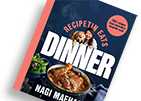
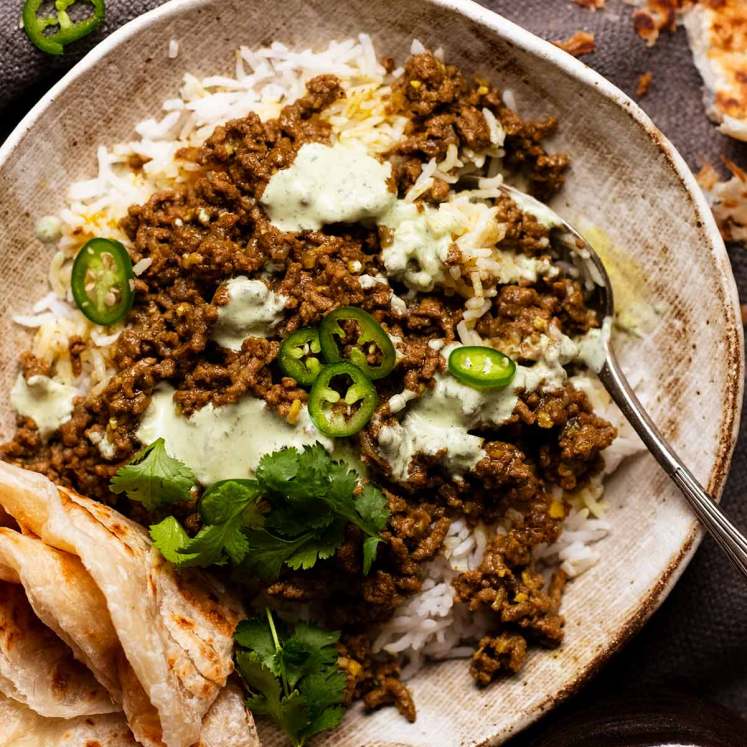
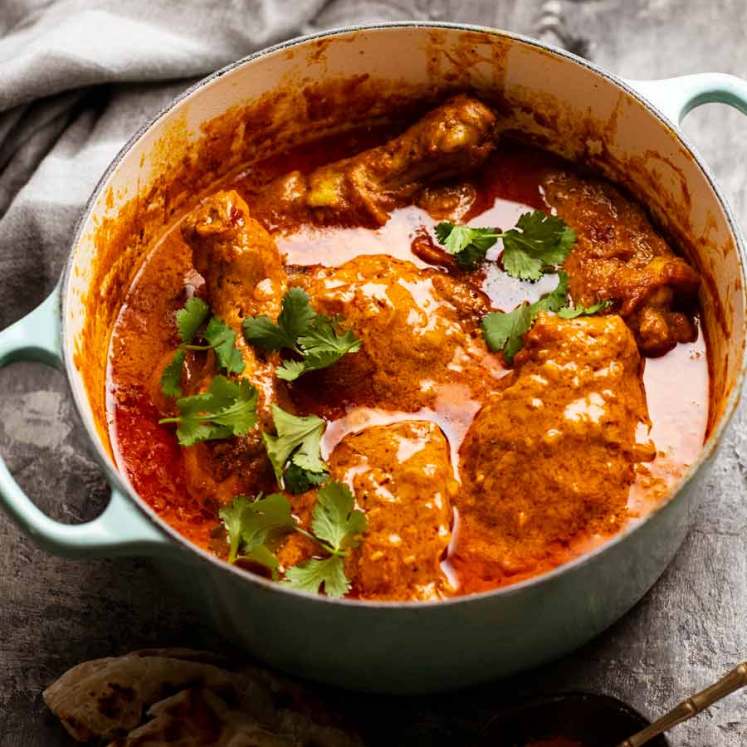
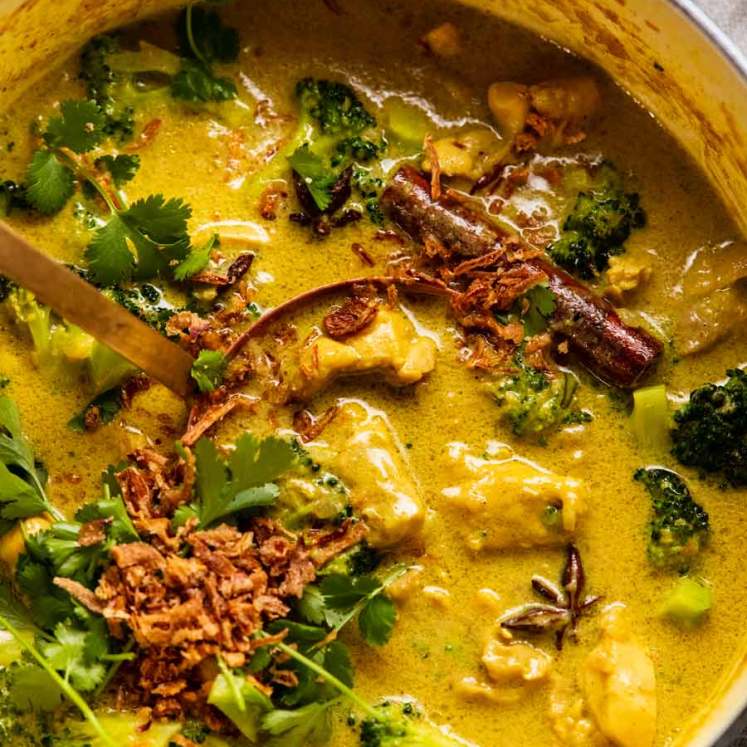
Hi Nagi
I hope this doesn’t sound heretical but being vegetarian, are there some substitutes for the shrimp and fish pastes that could be used in this recipe? I am always ready to experiment but what would be your suggestions?
Hi Henry – I’m so sorry to say that for this particular recipe, the key flavours are shrimp paste and fish sauce so unfortunately I don’t have substitutions to offer for this one. Green curry will be easier – it’s on my list as the next curry! 🙂 N x
This year I want to try preparing and eating new dishes. This one is at the top of my list. Great photos!!
Thanks Catherine!! Hope you do try it!!!
I wish I could make your recipe, and many others, but alas, I can’t get my hands on some of the fresh ingredients. It’s so pretty, but I’ll have to stick with the pre-made Thai curry pastes, which aren’t bad.
I know how you feel, we can’t always get ingredients in Australia for some ethnic foods – most especially spices. Mexican spices! We have barely any over here!! 😩
Oh man finally! I’ve been hanging for you to put this one up since I saw the sneaky peak on your Insta story.
🤣 PS If you ever get impatient, just give me a prod and I’ll bring it up the editorial calendar!!!
I made it and it’s fricken fantastic. You are a goddess.
🙌🏻
Luca says woof and keep warm super excited I ordered a really heavy powered food processor called sumeet it’s designed for grinding wet spices lentils etc for indian style cooking and should work wonderfully for the thai chilli in the paste.
will send pictures when done.. Have fun in Tokyo
The Summet machione looks amazing. Are they available locally n Australia?
Hi George. .nice to read you were asking about my prehistoric Sumeet asia food grinder. I have a couple of email address..their website
http://www.sumeet.net
Or this one .sumeetdirekt@gmail.com
Sorry Nagi..didn’t mean to untrue on you
Please don’t apologise! I love getting tips from readers! 🙂 N x
That sounds PERFECT for this! I’m so jealous, I really need to upgrade mine! 🙂 N xx
People can be peculiar! Well, I can! I make almost every ‘curry’ dish from 23 countries from scratch . . . give me Thai green or red, and I’ll buy the paste !! Lord knows why!!! And the red paste is SO easy compared to the green one and I even grow huge pots of lemongrass . . . Again you have given a nudge . . . yes, way back when I began with blachan . . .
Hail to the Curry Queen!!! AND you have your own lemongrass??? I’m so jealous 🙂
Ha! Ha! As you would well know the word ‘curry’ was a British invention NONE of these countries’ accept as far as name is concerned . . . Actually I like Goan and Keralan and Deccan and Rajasthani and . . . even the gorgeous SA ones like a well-made bobotie . . . well what would you do if both your bl . . .y husbands wanted such about 4 times a week !!!! Blame it all on love and sex . . .
Wow! You’re a legend Eha, I had no idea you were so into curries!!
Hi Nagi,
Just wondering if you can suggest the quantity of ground galangal to substitute the fresh grated galangal?
Hi Ratih! I haven’t tried it but the rule of thumb is to use half so I would start with 1.5 tsp of dried 🙂 N x
Oh my gosh! My mouth is watering from the photos! I LOVE Thai food and I’m so glad you posted this. I am definitely go to make it. One of my favorite dishes of all time is Panang. ; )
Hope you do try it Nancy! I would love to know what you think 🙂 Curry recipe coming on Monday! N x
Hi, Nagi,
We’ll be making this next week, and I wanted to thank you for all the tips and links to resources/ingredients. If you aren’t familiar with Penzeys Spices here in the US, they have tons of different blends, salt free options, single spices…just everything you can imagine. Including a wonderful ground Galangal which I’ve used. They will ship internationally, so all you have to do is contact them to make arrangements. It’s a very reliable company that I’ve been very happy with for years. One of their blends (salt free) that I always have in the house is Mural of Flavor. It’s good in everything! Hope you and that wet, wild and crazy Dozer have a fun weekend. 🙂
That’s such a wonderful tip Kin! Thank you so much for sharing that! N xx
I am going to try this…looks wonderful. BTW, did I miss how long this lasts in refrigerator???
Thanks:) Making your 15 min. chicken breasts for dinner tonight…I’ll report back.
BTW, I’m assuming the photo is chicken curry.. is the recipe posted? Looks totally yummy!
Hi Lyn! Coming Monday! 🙂 N xx
Hi Lyn! It’s in the notes under Storage: 3 days in the fridge, otherwise freeze it, it works so great!
Also, I wanted to mention Thai chef Pailin Chongchitnant who has great instructional vids on YouTube channel “Pailin’s Hot Thai Kitchen” and who recently published a Thai cookbook and won an award in Canada. Her vids are very comprehensive and taught me a lot of the basics for Thai cooking at home.
AWESOME! I love finding new cooking inspiration, especially for Asian foods! Thanks Martin! N x
A word to the shopper looking for Galangal. After many trips in search of, I FOUND IT in the freezer section of the Asian market, so don’t limit yourself to only looking in the produce area.
That’s a top tip Martin! Thanks!! N xx
I’m shaking in my boots, Dozer. After that performance does he lick you until you cry Uncle? And your red curry sounds amazing. I love trying different cuisines and this is one I’ll have to do once we get home ( that’s where our blender is). I’m pinning this recipe and I can’t wait to try it. I trust the recipe tin eats family judgment. Have a great weekend. xoxo
I know! Isn’t his face ridiculous??!! Have a wonderful weekend Marisa! N xx
Is there anything that I can use instead of Shrimp paste? I have a shellfish allergy.
Hi Diane! I’m sorry to say I am not sure what an adequate substitute would be, shrimp paste is a key flavour in red curry. Sorry! 🙁 N x
Great minds obviously think alike! I just did a post last week about making red, green and yellow curry pastes from scratch in 20 minutes. I swap the shrimp paste for fish sauce in mine due to the fact that it’s really expensive outside of London! And you are totally right once you go homemade you’ll never by a jar again!
Lovely recipe!
WOAH! You did the trio! You rock!!
Can’t wait! Can’t wait! Really big CANNOT wait for the rest of the recipe!!
😎 PS Didn’t mean to string out the torture, it was just that I thought it made sense to file them separately!!! N xx
No worries! It’s more fun this way — looking forward to the next part!
Yummy ! We love Thai in our household..so off to market I go to buy the ingredients. Will send you a picture of my finished product.
Lucky you Dozer the only water Luca has for mucking about is melting snow..it was 6 celcius on thursday.
I’m in Tokyo so I hear you on the cold Gillian!!!! It’s about 6C here during the days too!! Give Luca a big pat from me – N xx